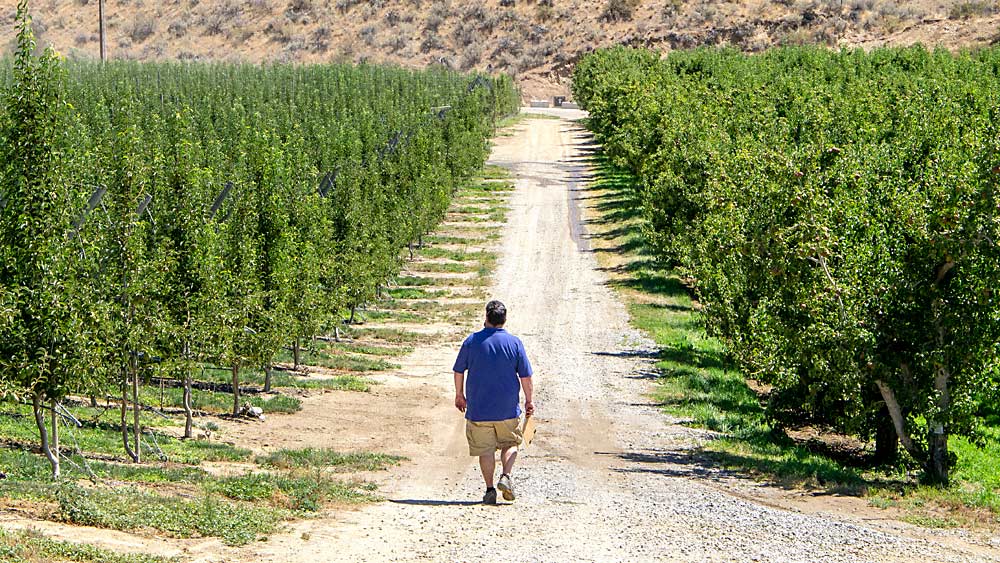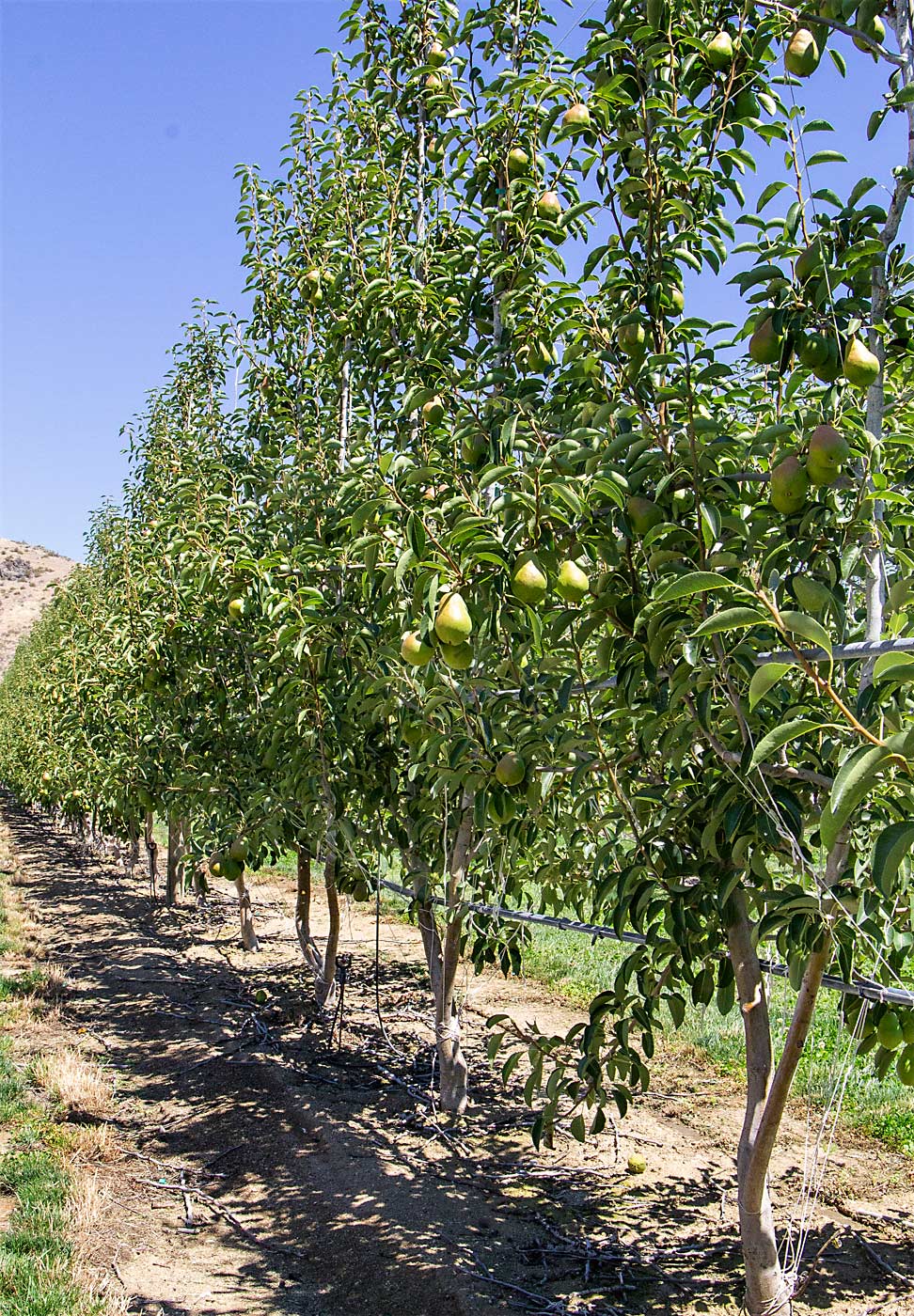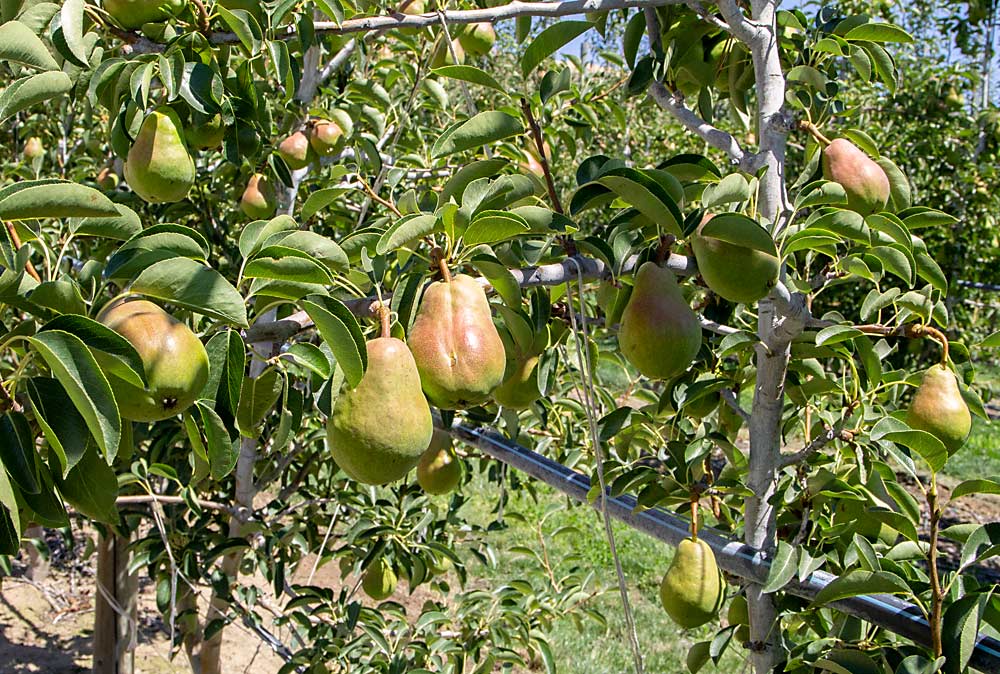
Pear growers seeking to modernize plantings don’t need to wait another decade for dwarfing quince rootstocks suitable for the Pacific Northwest to dabble in high density. By planting Bartletts in a two-leader system, Stemilt Growers of Wenatchee, Washington, created a pear block that resembles a 3-by-12 apple system in its fourth leaf.
“Bi-axis trees or a multileader tree is a nice way to divide the vigor,” said Stefano Musacchi, Washington State University endowed chair for tree fruit physiology, who advised Stemilt on the planting. “In this case, the root system is competing, because they are closer, and there’s more light interception so the system can be more efficient in improving the quality of the fruit.”
Stemilt hopes the system offers labor efficiencies and reduces the costs of production, said area manager Bryan Mrachek. The establishment years required intensive tree training, he said, but advantages are already apparent — lower spray bills, better coverage, less hand thinning and an efficient harvest — as the trees come into production.
While few pear growers are renovating orchards — waiting for new rootstocks, new cultivars or improving cash flows — Musacchi encouraged growers to consider planting medium-density trials such as Stemilt’s two-leader block to learn how to irrigate, fertilize, prune and train such different trees.
“The bi-axis now on existing rootstocks can be a learning stage for approaching high density later on,” he said. “If you establish a new orchard, try something different. I don’t want to push people out of their comfort zones, but the world is changing and what was good 80 years ago doesn’t mean it is good today.”

Training trees and crews
Mrachek and orchard manager Jorge Andrade discussed the establishment of the block during a WSU virtual field day last summer, hosted by Tory Schmidt, project manager for the Washington Tree Fruit Research Commission. They told Schmidt that they opted for OHxF 97, due to the site’s sandy soils, and spaced the twin-top knipboom trees every 6 feet, with 12-foot rows.
“It’s been a myriad of tree training, click pruning and other things to maximize the breaks,” Mrachek said. “Once you’ve got the vigor in a pear tree, getting it to settle down is not an easy thing to do.”
Click pruning, an approach Musacchi introduced to the Washington pear industry, employs a series of aggressive heading cuts to drive renewal of fruiting wood while maintaining a narrow canopy. Mrachek described it as a cycle that maintains balance in the branches over time: Cutting a branch back to a few buds promotes a strong response and a weak response; pruners then cut back the strong response and head the weak one to keep promoting small, fruitful wood.
Stemilt’s experienced crews quickly got the hang of it, but Mrachek recommended that for newer crews, pruning in two passes will help to simplify the number of rules for them to follow.
They also used hand pruners to score the trees in the first leaf, to promote branching, and applied Promalin (gibberellic acids and 6-benzyladenine) in the second leaf. They tied down branches, close to horizontal, to get more fruiting, Mrachek said, and then headed back those branches, selecting for a top bud.

Andrade said his crews like working in the new block compared to the open-center trees.
“We like to use the platforms. We don’t have to use the ladders for tree training or pruning,” he said. “Everything is more easy, it’s more safe, and it’s more cheap.”
Sprayers run faster and apply a lot less product, saving money while still achieving better coverage than in the big trees, Andrade added.
Mrachek expects another savings will come from more effective chemical thinning with MaxCel (6-benzyladenine) in the narrow canopy. “I don’t see the need for much if any hand thinning,” he said. “That’s a big one, too.”
First returns and eyeing ROI
In 2020, the fourth-leaf Bartlett block produced 18 bins per acre — a bit lower than Mrachek was expecting after a June drop. Picking crews flew through the block, he said, but didn’t need to use platforms since most of the crop was in the lower half of the trees.
A third-leaf block produced 8 bins an acre.
“It wasn’t really worth it to grow a crop in the third leaf,” he said in a follow-up interview. He opted to crop the trees, hoping that fruit would slow down the young trees, but not enough fruit stuck to slow them down. And because of the fruit, he couldn’t use Promalin to promote branching.
“It cut into structurally creating a lot of nice branches,” he said.

If he had it all to do over, Mrachek said he’d consider planting at 5 feet by 10 feet instead, to reduce the need for time-consuming training in the lower section of the trees, in favor of a simpler fruiting wall architecture
“Over the years, we spent $3,000 to $4,000 an acre on tree training. We could replace that with trees and not spend the labor on it,” he said. “That would simplify establishment, but we don’t know what it would look like once established.”
Now that the fourth-leaf trees have filled their space, he expects the trees to be straightforward to maintain with click pruning and easy to manage organically.
The narrower canopy offers multiple benefits beyond labor efficiency, Musacchi said, with easier pest control and more consistent fruit quality from more uniform trees.
“Many of the issues growers are facing with psylla and fire blight are related to canopies that are difficult to manage,” Musacchi said. “Unfortunately, many growers don’t have the money to replace their orchards right now. It’s like knowing the recipe but not being able to implement it.” •
—by Kate Prengaman






Leave A Comment